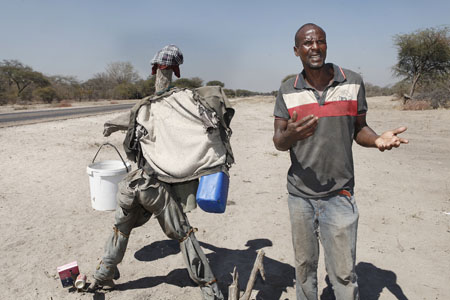Okavangos dolls mean business
11 Sep 2013
Stick and rag dolls have been used by children as play items from time immemorial. A little girl would go to every extent to make her rag doll look ‘human’. That included salvaging old clothes and rags from the wardrobe and the dump to cover the ‘baby’ with.
Once done, the little girl would cradle the dolls in her arms and coo in imitation of a nursing mother comforting her baby. With the advent of rubberiSed dolls, the stick and rag doll appears to be nearing extinction, but for the ingenuity of a community spread over nearly 400 kilometres.
Come along with us as we take the long drive from Sehithwa to Shakawe and get a chance to meet the Okavango’s life-sized stick and rag dolls. The dolls, each assuming its desired posture, invariably inhabit the roadside, eternally serving a purpose no mortal being could take.
They are the emotionless and motionless bus-stop marshals of the Okavango. And every dweller of the Okavango knows to slow down when a rag doll appears in the distance, for where stands a stick and rag doll, living humans are likely to await transport.
It is the life-sized design of the dolls that compels passersby to take a moment off their journey and behold – or even greet the motionless men by the roadside. You can tell they are men because they all wear trousers and hats. More importantly they have been given the macho features of a man.
A visitor is likely to be curious about the dolls, but for the Sehithwa- Shakawe regular road user the dolls do no such things. However, they are invaluable items that help them realize they have reached a bus-stop.
It is almost taboo not to slow down at the sight of a stick and rag doll. As for bus drivers, they know it is time to slow down and check if there are any people waiting for the bus at the static man’s abode. None of the dolls wears the same clothes as the other, so the bus driver knows to ‘stop by the man with the blue cap!’ or red trousers as according to the request of a customer who hollers from the backseat.
The dolls are not merely bus stop ‘marshals’. They are also important directional instruments – compasses for pedestrians, especially those who live in the cattle posts where there is no formal signage to indicate that someone has reached the diversion road to their cattle post. Many people forsook the ancient idea of using trees as markers as that had become a cumbersome undertaking because the big trees along the road are identical, and have more and more relied on the infallibility of the dolls.
But two stick and rag dolls along the road take the prize for peculiarity. The two have ‘picked’ a spot just outside Nokaneng, which lies some 30 kilometres south of Gumare. The dolls stand on either side of the road, and each is holding a 20 litre white plastic bucket. The two ‘dudes’ are not simple bus stop marshals. They also play a loftier role as advertising agents. The empty container tell other residents and visitors that milk and madila (sour milk) are sold at the roadside Ngatunwe cattle post.
Bokamoso Nyathi is the brains behind the two stickmen.
“The two dolls have helped increase my sales because curious passers-buy tend to stop and ask about the dolls,” he says. Those who ask are normally visitors, and the more likely to buy his milk and madila. The rest of the community, though do not need to be educated on the significance of stick and rag dolls that carry buckets.
“It is common knowledge in the Okavango that if a doll carries a bucket, he is advertising milk or madila”, says Nyathi.
From the look of it, nothing could beat the effectiveness of Okavango’s stick and rag dolls as bus stop marshals and as instruments of direction, or even as advertising agents. The dolls are simply poised for eternal domination of the unmarked Okavango bus and hiking stops. They are the last of a surviving generation of stick and rag dolls, an eternal assurance that the stick and rag doll shall not follow the trail of the Dodo bird. ENDS
Source : BOPA
Author : Portia Keetile
Location : Gaborone
Event : Feature article
Date : 11 Sep 2013






